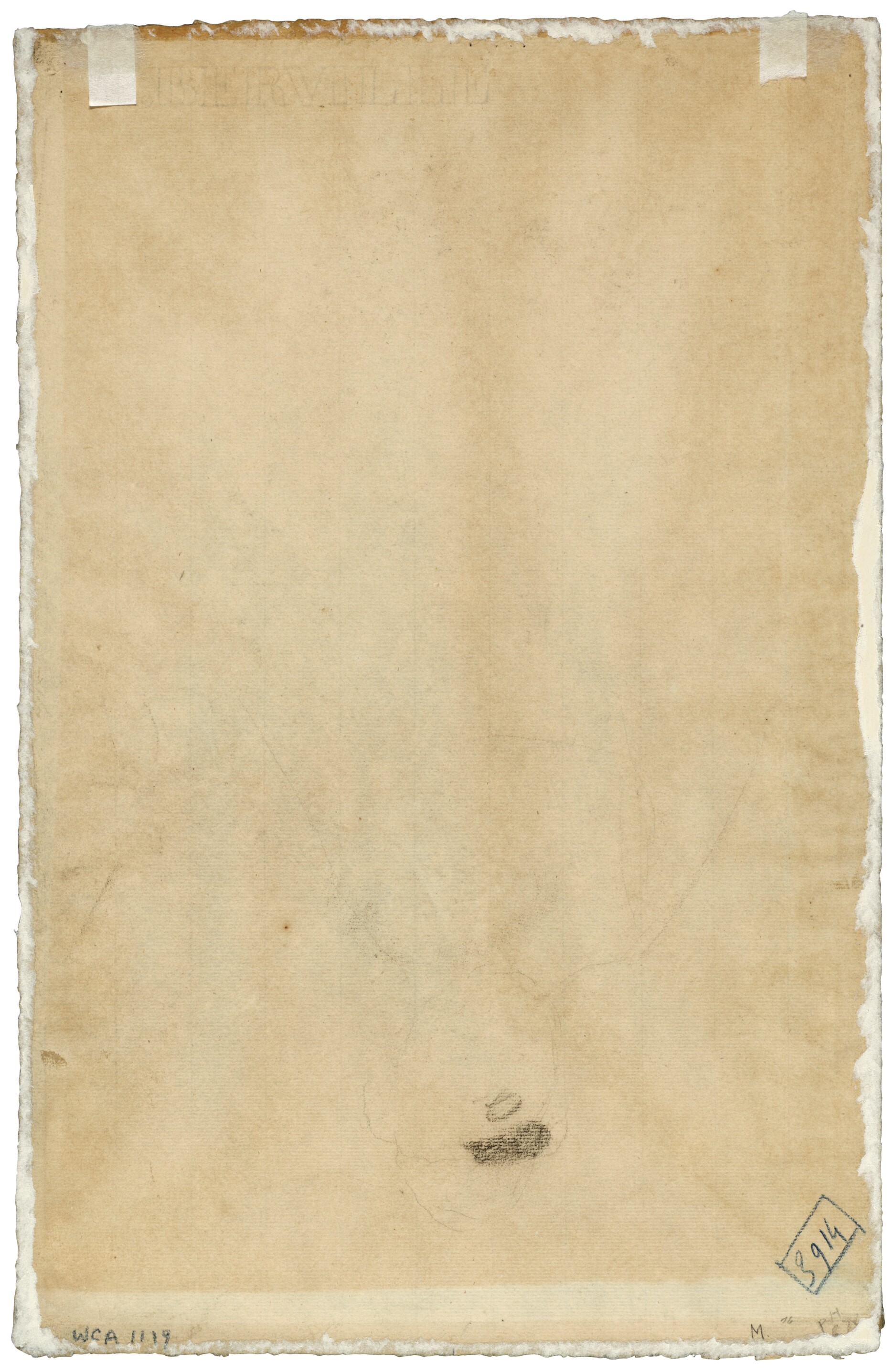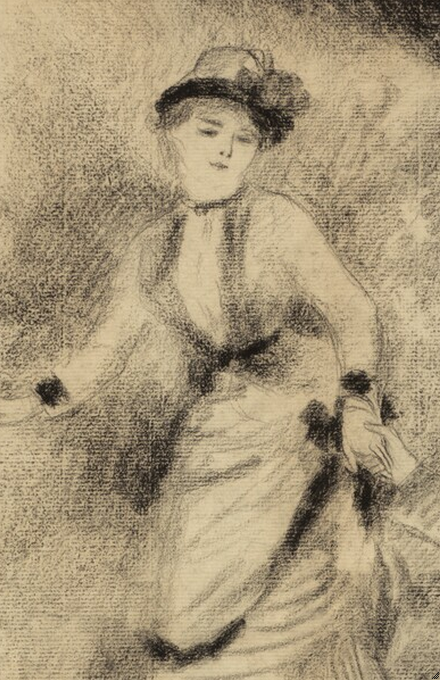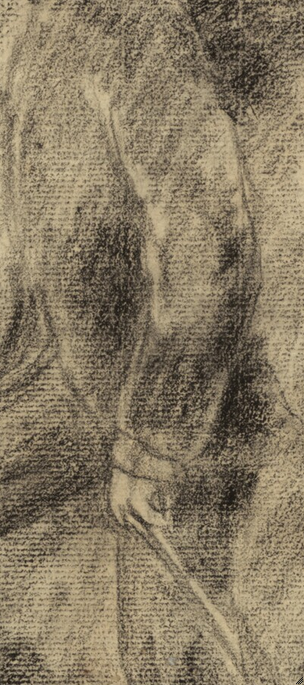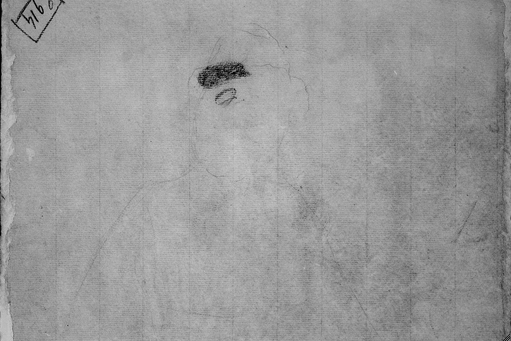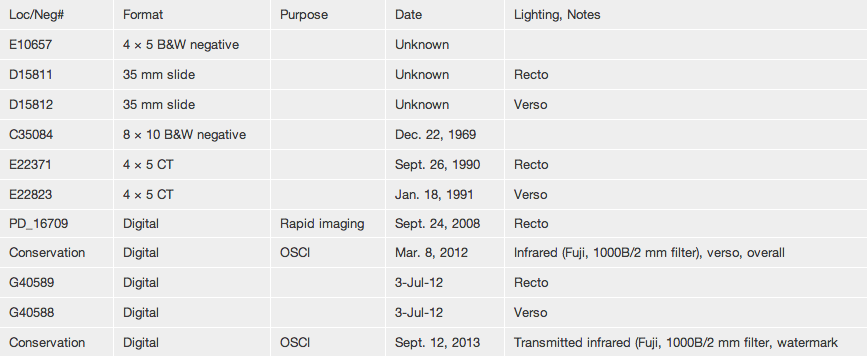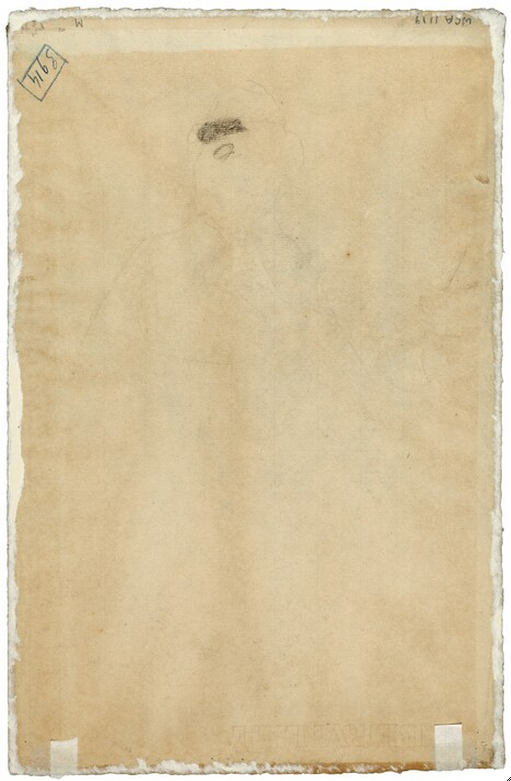Cat. 13
The Descent from the Summit: Jean Martin Steadies Hélène, the Banker’s Daughter (Illustration for Edmond Renoir’s “L’étiquette”) (recto) Half-Length Sketch of a Woman (verso)
1881
Black chalk on ivory laid paper, discolored to tan; 492 × 319 mm
The Art Institute of Chicago, gift of Mr. and Mrs. B. E. Bensinger, 1969.870R, 1969.870V
Technical Report
Technical Summary
The Descent from the Summit: Jean Martin Steadies Hélène, the Banker’s Daughter is executed in black chalk on ivory [glossary:laid] paper that discolored to tan as a result of light exposure and possibly contact with an acidic mount. Renoir worked out his composition with a variety of chalk lines. He established the overall forms of the two figures with fairly thick lines, defined their hands and faces with delicate thin lines, and accentuated the hatbands, dress cuffs, and decorative ribbons with dense, broad strokes (fig. 1.1). The chalk was sufficiently hard to delicately render the clasped figures’ hands. The artist created a sense of space around the two figures by lightly filling in the broad expanses with black chalk, and there is a vague suggestion of background at the upper right. Renoir extended the composition, filling the paper support and working up to 4 cm from the edges. Highlights were established by leaving the light tonality of the paper exposed (fig. 5.11). There is no evidence of [glossary:stumping] or erasure.
There is a faint drawing of a figure in black chalk on the verso (fig. 5.12; infrared detail,fig. 1.3).
Media and Support
Support Characteristics
Primary paper type
Ivory (discolored to tan), medium-thick, moderately textured laid paper.
Watermark
L. Berville (right, top edge) (fig. 1.4).
Chain line orientation and frequency
Vertical, 2.8 cm.
Laid line frequency
8–9 per cm.
Furnish
Uniform, without visible inclusions or colored fibers.
Formation
Even.
Other characteristics
There are [glossary:deckle edges] at the top, right, and bottom; the left side is edge torn.
Dimensions
492 × 319 mm.
Preparatory Layers
No artistic surface alterations or coatings are visible under normal conditions, in [glossary:UV] illumination, or with magnification. Under UV illumination, there is a pale-yellow visible-light [glossary:fluorescence] overall on the paper surface that is characteristic of a light gelatin surface [glossary:sizing].
Media Characteristics
The work was drawn in black chalk. The rich black color and the fine, uniform appearance of the particles under magnification suggest that the chalk was synthetically produced. Various hardnesses of chalk were likely employed, as well. Renoir probably achieved the thin delicate lines in the figures’ hands and faces with a hard black chalk, and he probably used a soft black chalk to accentuate elements of the clothing. There is no evidence of stumping or erasure.
There is a faint drawing of a figure in black chalk on the verso at the bottom of the sheet.
Compositional Development
No revisions or changes are visible in the composition in normal conditions or under magnification.
Surface Treatment
No artistic surface fixative or coatings are visible in normal conditions, under UV illumination, or under magnification.
Condition History
The ivory paper has discolored overall to tan and is darkest along the bottom edge and on the verso. The bottom edge is creased, possibly from being formerly folded back upon the verso, where the paper was in direct contact with an acidic material that caused the paper to discolor. The paper along the bottom edge of the sheet on the verso, formerly in the interior of the fold, was protected from the acidic material and thus its tonality is preserved. The support was formerly adhered along the edges of the verso to an acidic secondary support, contributing to the pronounced discoloration on the verso. Residual white paper and adhesive are evident on the verso. A few edge tears, visible along the top, the lower right, and the bottom edges of the verso are stabilized by the former mount remnants.
Light media transfer is visible around the perimeter on the recto. It is most pronounced along the top edge. There are stray marks in blue colored pencil (a similar medium to that used in the marks) along the upper half of the right edge.
Kimberly Nichols
Provenance
Possibly Ambroise Vollard (1867–1939), Paris.
Purchased jointly by M. Knoedler and Company, New York, and French Art Galleries, New York, Mar. 7, 1949.
Sold by M. Knoedler and Company, New York, to T. Edward Hanley (1894–1969), Bradford, Pa., May 10, 1949.
T. Edward Hanley to E. V. Thaw and Company, New York.
Sold by E. V. Thaw and Company, New York, to Benjamin E. Bensinger (1905–1976), Chicago, Mar. 9, 1967.
Given by Mr. and Mrs. Benjamin E. Bensinger to the Art Institute of Chicago, 1969.
Exhibition History
Philadelphia Museum of Art, T. Edward Hanley Collection, 1957.
Buffalo, N.Y., Fine Arts Academy, Albright Art Gallery, The T. Edward Hanley Collection, Jan. 6–Feb. 14, 1960, cat. 110.
New York, Wildenstein and Company, Loan Exhibition of Paintings and Drawings from the Hanley Collection, Nov. 22–Dec. 30, 1961, p. 13, cat. 102.
Cambridge, Mass., Fogg Art Museum, T. Edward Hanley Exhibition, Jan. 24–Apr. 15, 1962, cat. 104.
Selected References
Ambroise Vollard, Tableaux, pastels et dessins de Pierre-Auguste Renoir, vol. 1 (A. Vollard, 1918), p. 10, no. 38 (ill.).
Ambroise Vollard, La vie et l’oeuvre de Pierre-Auguste Renoir (A. Vollard, 1919), p. 180 (ill.).
Walter Pach, Renoir (Abrams, 1950), p. 12 (ill.).
Walter Pach, Auguste Renoir: Leben und Werk (M. Dumont Schauberg, 1976), pp. 26–27, no. 18 (ill.).
Harold Joachim and Sandra Haller Olsen, French Drawings and Sketchbooks of the Nineteenth Century, vol. 2 (University of Chicago Press, 1979), p. 90, no. 5D6.
Douglas W. Druick, Renoir, Artists in Focus (Art Institute of Chicago/Abrams, 1997), pp. 91, no. 10 (ill.), 110.
John House, Pierre-Auguste Renoir: La Promenade (J. Paul Getty Museum, 1997), pp 78–79, fig. 51.
Martha Tedeschi, “Pierre Auguste Renoir, Workers’ Daughters on the Outer Boulevard (Illustration for Emile Zola’s ‘L’Assommoir’), 1877/78,” in “Maineri to Miró: The Regenstein Collection since 1975,” special issue, Art Institute of Chicago Museum Studies 26, 1 (2000), p. 80 (ill.).
Guy-Patrice Dauberville and Michel Dauberville, with the collaboration of Camille Frémontier-Murphy, Renoir: Catalogue raisonné des tableaux, pastels, dessins, et aquarelles, vol. 1, 1858–1881 (Bernheim-Jeune, 2007), p. 612, no. 658 (ill.).
Other Documentation
Inscriptions and Distinguishing Marks
Recto
Mark
Location: lower right corner
Method: graphite
Content: R
Mark
Location: left bottom edge
Method: graphite
Content: 29/43
Verso
Mark
Location: lower right corner
Method: green-blue crayon
Content: 3914
Mark
Location: left bottom edge
Method: green-blue crayon
Content: WCA 1119
Examination Conditions and Technical Analysis
Raking Visible Light
Paper [glossary:support] characteristics identified.
Transmitted Infrared (Fuji 1.0–1.1 μm)
Watermark captured.
Transmitted Visible Light
Paper mold characteristics identified.
Ultraviolet-Induced Visible Fluorescence (365 nm)
Residual mount adhesive and light surface sizing detected.
Infrared Reflectography (Fujifilm S5 Pro with X-Nite 1000B/2 mm filter [1.0–1.1 μm])
Captured faint [glossary:graphite] drawing on verso in the lower area.
Stereomicroscopy (80–100×)
Media identified.
Image Inventory
The image inventory compiles records of all known images of the artwork on file in the Imaging Department and in the conservation and curatorial files in the Department of Prints and Drawings at the Art Institute of Chicago (fig. 6.14).

